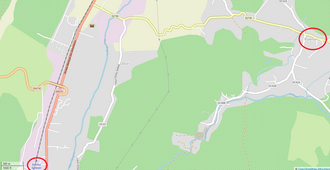Decauville Railway Poienari – Schitu Goleşti
| Decauville Railway Poenari – Schitu Goleşti | |||||||||
|---|---|---|---|---|---|---|---|---|---|
|
Engineer Pierre Domette Boussard on the Decauville Railway of
the lignite mine in Poienari near Schitu Goleşti | |||||||||
|
The Poienari and Schitu Goleşti settlements
| |||||||||
| Route length: | 5 km | ||||||||
| Gauge : | 600 mm ( narrow gauge ) | ||||||||
|
|||||||||
The Decauville Railway Poenari – Schitu Goleşti was a five-kilometer narrow-gauge railway from the lignite mine in Poienari (obsolete Poenari ) to the standard-gauge railway station in the southwestern Schitu Goleşti in the Argeş district in Romania .
history
The brown coal mine in the municipality of Poienari initially had an area of 869 hectares. It was put into operation in 1906 by Stoicescu, the first concessionaire. Until 1909, Stoicescu mined lignite there with primitive methods on the left bank of the Măgherița River . The transport was carried out with carts that drove through the Poienari Valley. The rolling stock consisted of a few cars and a 100-meter-long Decauville railway. The length of the tunnels was 800 meters over an area of three hectares.
In June 1906 the company of II Beligrădeanu Fils from Craiova resumed exploitation. From 1909 the mine was modernized under the direction of the French engineer Pierre Domette Boussard by building a ramp for loading the lignite, better supports in the tunnels, and the construction of garages and workshops. Around 1909 he had a 5-kilometer-long Decauville railway laid with a gauge of 600 mm, which connected the mine with the station in Schitu Goleşti.
In addition to the construction of the mechanical systems above ground, a compressed air tank and compressed air lines for the jackhammers were laid underground. From 1913/1914 satisfactory results were achieved with an electric excavator. In 1916, the mine tunnels were 6,500 meters long and covered an area of 10 hectares.
During the First World War, the mine was continued by the German occupation. In order to extract as much lignite as possible as quickly as possible, only the most productive places were used, drainage was neglected, and savings were made when buying wood for the tunnels. As a result, the mine was badly affected, so that restarting seemed temporarily impossible.
In the post-war period, two generators with 50 and 80 HP were installed for power generation, a Sulzer pump for drainage and a Babcok and Choavald boiler for the jackhammers.
The Decauville Railway was operated with three locomotives in 1923. The tunnels of the mine, which were still in use at that time, had a length of 4200 meters on 5 floors on an area of 20 hectares.
Delivery rates
- 1909: 3,539 tons
- 1910: 13,365 tons
- 1911: 18,107 tons
- 1912: 22,476 tons
- 1913: 20,583 tons
- 1914: 20,000 t
- 1915: 24,110 tons
- 1916: 25,867 tons
- 1917: 12,784 tons
- 1918: 17,346 tons
- 1919: 10,570 tons
- 1920: 8,798 t
- 1921: 14,582 tons
- 1922: 21,653 tons
Individual evidence
- ↑ Information on the website of the municipality of Poienarii de Muscel accessed on October 31, 2019 (Romanian).
- ↑ Exploatarea Minelor de Lignit II Beligrădeanu Fils, Gara Schitu-Golești, Poenarl. Around 1923 (Romanian).
- ↑ Jean Domette: Explotacion de las minas de carbon II Beligradeanu Hijo. June 9, 2011 (Spanish).
- ↑ Economic-commercial part: Annual reports of industry and trade. December 20, 1912.
Coordinates: 45 ° 12 ′ 15.8 " N , 25 ° 0 ′ 10.8" E

